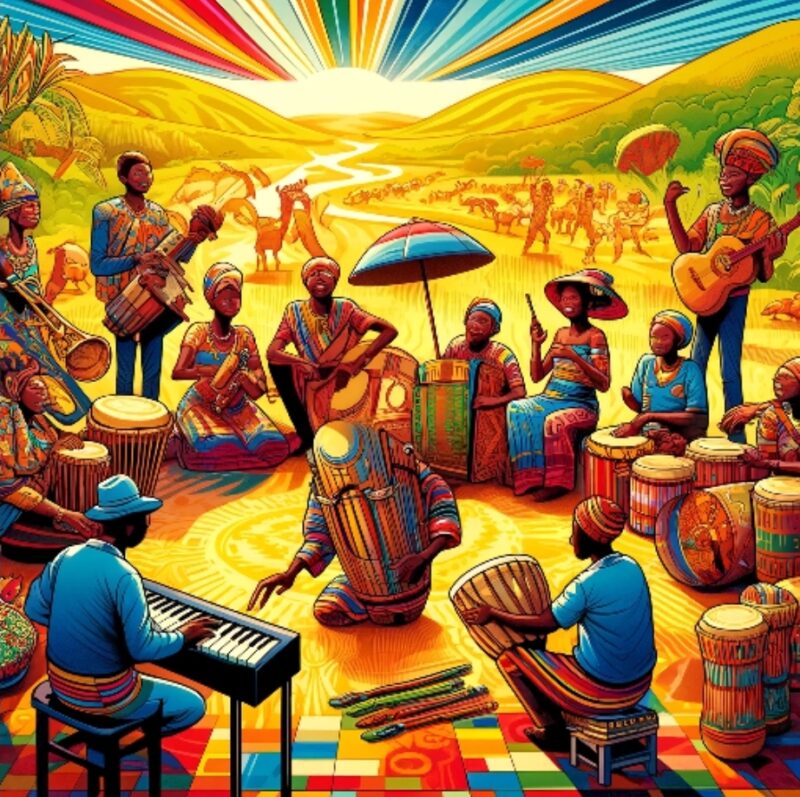Exploring the Unique Soundscapes of Zambian Music

source: DALL-E
Zambian music offers a distinctive cultural soundtrack. This article delves into how Zambia’s music uniquely stands out from other African sounds. Rich in diversity, it draws from various ethnic traditions. The sounds are deeply rooted in local customs and stories. Instruments like the thumb piano and the bongo drum are prevalent. They create rhythms that echo Zambia’s landscapes. This music is vibrant and full of life, reflecting the community’s spirit. Each melody and rhythm tells a story, from ancient tales to contemporary struggles. Zambian artists bring these stories to life, capturing the essence of their heritage and surroundings. This unique approach sets Zambian music apart, making it a significant cultural marker in Africa.
Roots and Evolution
Traditional Zambian music is rich and varied. It comes from the many ethnic groups across the country. Drums and singing are central in cultural celebrations, capturing the essence of community gatherings. Over time, these traditional elements have blended with modern influences. This mix helps keep the music’s roots alive while letting it grow and change. Instruments like the kalimba and ngoma drum produce distinct sounds that define Zambian music. These instruments now also include modern rhythms, forming a lively and colorful musical mosaic. Despite these updates, the heart of Zambian music stays true to its origins. This strong link to its past ensures that traditional music continues to flourish, connecting with both the older generations and attracting new fans. This lasting appeal keeps the music vibrant, making it a cherished part of Zambia’s cultural legacy.
Kalindula: The Heartbeat of Zambia
Kalindula is central to Zambia’s musical landscape. It mixes traditional rhythms with modern instruments like guitars and banjos. The lyrics talk about everyday life, love, and social issues, connecting deeply with listeners. Kalindula gives a voice to the community, sharing their joys, struggles, and stories. The blend of old and new sounds makes Kalindula vibrant and rich, attracting a broad audience. It reflects Zambia’s spirit and diversity, making it a key tool for storytelling and cultural sharing. As a major part of Zambian music, Kalindula does more than entertain. It educates and inspires, creating a deep connection with people all over Zambia. This genre helps preserve cultural heritage while evolving with contemporary influences, keeping it relevant and meaningful for new generations.
Influence of Zamrock
The 1970s saw Zamrock emerge in Zambia, reshaping its musical scene. This genre mixes rock with traditional Zambian tunes. Bands like Witch and Amanaz led this trend. They blended electric guitars with rock motifs into local music. This mix formed a distinct sound. It merged global rock’s dynamism with unique local beats. Zamrock reflected the worldwide rock scene while adding a Zambian flair. It kept culturally relevant. This fusion produced a vibrant, engaging style. It attracted audiences both in Zambia and abroad. Zamrock thus became a key part of Zambia’s musical heritage.
Modern Trends and Fusion
Zambian music keeps changing and growing. Today’s artists mix hip-hop, R&B, and reggae with local sounds. This new blend is catching on all over the world. Thanks to the internet, Zambian music can reach fans far and wide much more easily. Artists from Zambia are now getting attention across different countries. They share Zambia’s special music with the whole world. This helps more people learn about Zambian music. It also shows off the rich variety of Zambia’s culture. The mix of old and new styles is making Zambian music a big part of the global music scene.
Cultural Impact and Global Reach
Zambian music is more than just fun. It helps keep Zambia’s culture alive and shares it with the world. The music tells stories of the country’s traditions and history. It lets people everywhere get a peek into Zambia’s rich heritage. Music festivals and concerts are key to this. They bring Zambian music to both local and international audiences. At these events, you can hear everything from old tunes to modern beats. Just as playing at Vave Casino brings people together around a shared interest, these music events connect fans around the globe. They celebrate Zambia’s unique sounds and build cultural connections.
Challenges and Opportunities
Zambian music has to face many challenges, like copyright issues and funding shortages. These obstacles can hinder the development and distribution of music. However, there are significant opportunities for growth. International collaborations provide a pathway to new markets and creative fusion, enhancing the global appeal of Zambian music. Additionally, online platforms open doors for artists to reach wider audiences with fewer geographical restrictions. These digital spaces allow for direct engagement with fans and easier monetization of music, presenting promising avenues for overcoming some of the financial challenges facing the industry.
Conclusion
Zambian music reflects the nation’s spirit. Like understanding betting strategies, appreciating this music needs an awareness of its roots. Zambian music continues to inspire worldwide. It promises a vibrant future for this dynamic art form.

6 Comments
Tamra Phelps
Now that is interesting. I hadn’t thought about Zambian music but I will check it out on YouTube.
Alexis
Zambian music is truly beautiful!
Terri Quick
Thank you for sharing this
Jill Y
I’ve never heard of Zambian music, but I do know that regional/country music can be a huge part of the culture.
heather
I don’t think that I have ever listened to Zambian music before. I will have to check it out.
l p
thank you for this fascinating introduction to Zambian music. we’re in danger of losing so much.